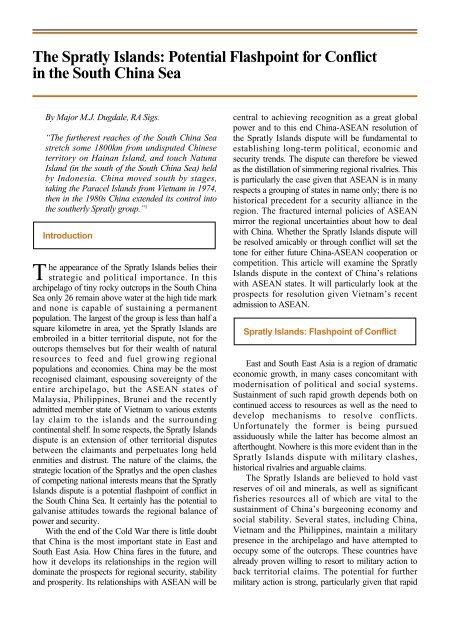ISSUE 125 : Jul/Aug - 1997 - Australian Defence Force Journal
ISSUE 125 : Jul/Aug - 1997 - Australian Defence Force Journal
ISSUE 125 : Jul/Aug - 1997 - Australian Defence Force Journal
Create successful ePaper yourself
Turn your PDF publications into a flip-book with our unique Google optimized e-Paper software.
The Spratly Islands: Potential Flashpoint for Conflictin the South China SeaBy Major M.J. Dugdale, RA Sigs.“The furtherest reaches of the South China Seastretch some 1800km from undisputed Chineseterritory on Hainan Island, and touch NatunaIsland (in the south of the South China Sea) heldby Indonesia. China moved south by stages,taking the Paracel Islands from Vietnam in 1974,then in the 1980s China extended its control intothe southerly Spratly group.” 1IntroductionThe appearance of the Spratly Islands belies theirstrategic and political importance. In thisarchipelago of tiny rocky outcrops in the South ChinaSea only 26 remain above water at the high tide markand none is capable of sustaining a permanentpopulation. The largest of the group is less than half asquare kilometre in area, yet the Spratly Islands areembroiled in a bitter territorial dispute, not for theoutcrops themselves but for their wealth of naturalresources to feed and fuel growing regionalpopulations and economies. China may be the mostrecognised claimant, espousing sovereignty of theentire archipelago, but the ASEAN states ofMalaysia, Philippines, Brunei and the recentlyadmitted member state of Vietnam to various extentslay claim to the islands and the surroundingcontinental shelf. In some respects, the Spratly Islandsdispute is an extension of other territorial disputesbetween the claimants and perpetuates long heldenmities and distrust. The nature of the claims, thestrategic location of the Spratlys and the open clashesof competing national interests means that the SpratlyIslands dispute is a potential flashpoint of conflict inthe South China Sea. It certainly has the potential togalvanise attitudes towards the regional balance ofpower and security.With the end of the Cold War there is little doubtthat China is the most important state in East andSouth East Asia. How China fares in the future, andhow it develops its relationships in the region willdominate the prospects for regional security, stabilityand prosperity. Its relationships with ASEAN will becentral to achieving recognition as a great globalpower and to this end China-ASEAN resolution ofthe Spratly Islands dispute will be fundamental toestablishing long-term political, economic andsecurity trends. The dispute can therefore be viewedas the distillation of simmering regional rivalries. Thisis particularly the case given that ASEAN is in manyrespects a grouping of states in name only; there is nohistorical precedent for a security alliance in theregion. The fractured internal policies of ASEANmirror the regional uncertainties about how to dealwith China. Whether the Spratly Islands dispute willbe resolved amicably or through conflict will set thetone for either future China-ASEAN cooperation orcompetition. This article will examine the SpratlyIslands dispute in the context of China’s relationswith ASEAN states. It will particularly look at theprospects for resolution given Vietnam’s recentadmission to ASEAN.Spratly Islands: Flashpoint of ConflictEast and South East Asia is a region of dramaticeconomic growth, in many cases concomitant withmodernisation of political and social systems.Sustainment of such rapid growth depends both oncontinued access to resources as well as the need todevelop mechanisms to resolve conflicts.Unfortunately the former is being pursuedassiduously while the latter has become almost anafterthought. Nowhere is this more evident than in theSpratly Islands dispute with military clashes,historical rivalries and arguable claims.The Spratly Islands are believed to hold vastreserves of oil and minerals, as well as significantfisheries resources all of which are vital to thesustainment of China’s burgeoning economy andsocial stability. Several states, including China,Vietnam and the Philippines, maintain a militarypresence in the archipelago and have attempted tooccupy some of the outcrops. These countries havealready proven willing to resort to military action toback territorial claims. The potential for furthermilitary action is strong, particularly given that rapid
















